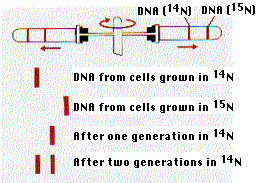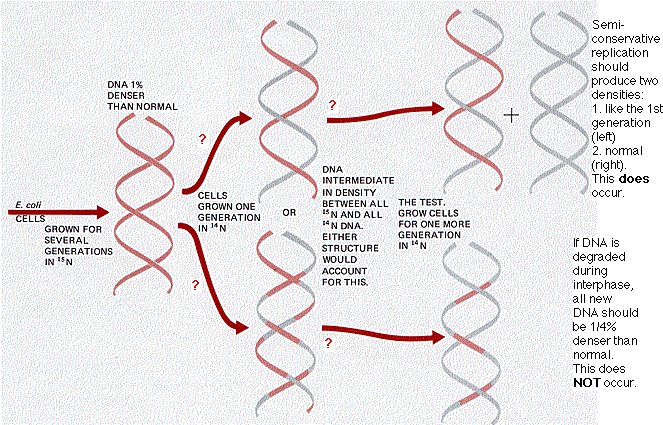This mode of replication is described as semiconservative: one-half of each new molecule of DNA is old; one-half new.
Link to discussions of:
|
While Watson and Crick had suggested that this was the way the DNA would turn out to be replicated, proof of the model came from the experiments of M. S. Meselson and F. W. Stahl.

They grew E. coli is a medium using ammonium ions (NH4+) as the source of nitrogen for DNA (as well as protein) synthesis. 14N is the common isotope of nitrogen, but they could also use ammonium ions that were enriched for a rare heavy isotope of nitrogen, 15N.
After growing E. coli for several generations in a medium containing 15NH4+, they found that the DNA of the cells was heavier than normal because of the 15N atoms in it.
The difference could be detected by extracting DNA from the E. coli cells and spinning it in an ultracentrifuge. The density of the DNA determines where it accumulates in the tube.
Then they transferred more living cells that had been growing in 15NH4+ to a medium containing ordinary ammonium ions (14NH4+) and allowed them to divide just once.The DNA in this new generation of cells was exactly intermediate in density between that of the previous generation and the normal.
This, in itself, is not surprising. It tells us no more than that half the nitrogen atoms in the new DNA are 14N and half are 15N. It tells us nothing about their arrangement in the molecules.
However, when the bacteria were allowed to divide again in normal ammonium ions (14NH4+), two distinct densities of DNA were formed:
As this interpretative figure indicates, their results show that DNA molecules are not degraded and reformed from free nucleotides between cell divisions, but instead, each original strand remains intact as it builds a complementary strand from the nucleotides available to it.
This is called semiconservative replication because each daughter DNA molecule is one-half "old" and one-half "new".
Immortal strands. Note that the "old" strand (the red one in the top half of the figure) is immortal because — barring mutations or genetic recombination — it will continue to serve as an unchanging template down through the generations.
E. coli is a bacterium, but semiconservative replication of DNA also occurs in eukaryotes. And because each DNA molecule in a eukaryote is incorporated in one chromosome, the replication of entire chromosomes is semiconservative as well. This also means that the eukaryotic chromosome contains one "immortal strand" of DNA.
| Link to an illustrated demonstration of the semiconservative replication of chromosomes and the significance of their "immortal strands". |
| Welcome&Next Search |